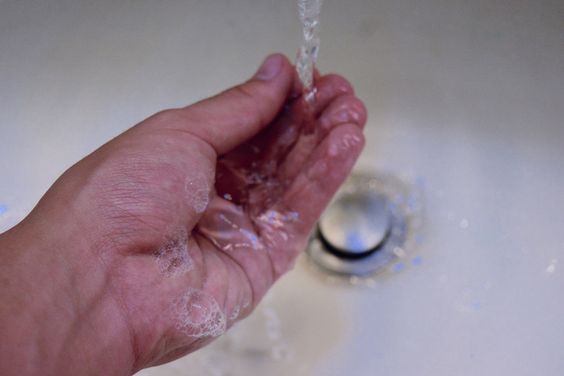How to Get Food Color Off Skin
Understanding Food Color Stains
Food colors come in various forms, including liquid, gel, and powder, each with its own staining properties. Factors such as the type of food coloring used, its concentration, and the duration of exposure can influence the intensity of stains on the skin. Understanding these factors is crucial for effective stain removal. Discover about How Long to Boil Hot Dogs
Prevention is Key
Prevention is often the best approach when it comes to dealing with food color stains. Wearing protective clothing and gloves while handling food colorants can significantly reduce the risk of staining your skin. Additionally, being mindful of spills and splatters during the cooking process can help minimize the chances of staining.
Immediate Action: Removing Fresh Stains
In the event of a spill or splatter, quick action is essential to prevent the stain from setting. Begin by rinsing the affected area with warm water and mild soap. For stubborn stains, gently scrubbing with a mixture of baking soda and water or lemon juice can help lift the color from the skin.
Long-term Solutions: Removing Set-in Stains
For stains that have already set into the skin, a more thorough approach may be required. Commercial stain removal products specifically designed for skin can be effective, but be sure to follow the manufacturer’s instructions carefully. Alternatively, homemade remedies such as a paste made from baking soda and vinegar or a mixture of hydrogen peroxide and dish soap can help break down stubborn stains. Learn about How to Blanch Green Beans
Safety Considerations
When choosing a stain removal method, it’s important to consider your skin type and any sensitivities you may have. Harsh chemicals and abrasive techniques can cause irritation or damage to the skin, so always opt for gentle and non-abrasive methods whenever possible.
Natural Remedies
Natural ingredients such as coconut oil, olive oil, or aloe vera gel can also be effective at removing food color stains while nourishing the skin. These natural remedies are especially beneficial for individuals with sensitive skin, as they are less likely to cause irritation or adverse reactions.
Seeking Professional Help
If you’re unable to remove stubborn stains on your own, don’t hesitate to seek professional help. A dermatologist or skincare specialist can offer personalized advice and recommend treatments tailored to your specific needs. Professional treatments such as chemical peels or laser therapy may be necessary for particularly stubborn stains.
Tips for Specific Skin Types
Different skin types may require different approaches when it comes to stain removal. Individuals with sensitive skin should opt for gentle and natural remedies, while those with oily or acne-prone skin may benefit from products specifically formulated for their skin type.
Educational Campaigns and Resources
Raising awareness about food color stain removal techniques is essential for empowering individuals to take control of their skin health. Educational campaigns, online resources, and informational materials can provide valuable guidance and support for those seeking assistance with stain removal.
Common Myths Debunked
There are many misconceptions surrounding food color stain removal, including the belief that harsh scrubbing or abrasive techniques are necessary to remove stains. In reality, these methods can often do more harm than good, causing irritation and damage to the skin.
Environmental Impact
It’s also important to consider the environmental impact of stain removal products and techniques. Many commercial products contain harsh chemicals that can be harmful to the environment, so opting for eco-friendly alternatives is beneficial for both your skin and the planet.
Innovations in Stain Removal Technology
Advancements in stain removal technology have led to the development of innovative products and techniques that are both effective and environmentally friendly. From biodegradable detergents to eco-friendly stain removers, there are plenty of options available for those looking to reduce their environmental footprint.

Case Studies and Success Stories
Real-life examples of individuals successfully removing food color stains from their skin can provide valuable insight and inspiration for others facing similar challenges. By sharing their experiences and testimonials, these individuals can help others navigate the process of stain removal with confidence.
Conclusion
Removing food color stains from the skin can be a challenging task, but with the right knowledge and techniques, it is entirely possible. By taking preventive measures, acting quickly to remove fresh stains, and utilizing effective long-term solutions, you can keep your skin clean and healthy, even in the face of culinary mishaps.
FAQs
- Can food color stains cause skin irritation?
- In some cases, food color stains can cause irritation, especially if left on the skin for an extended period. It’s essential to remove stains promptly and choose gentle removal methods to minimize the risk of irritation.
- Are natural remedies effective for removing food color stains?
- Yes, natural remedies can be effective for removing food color stains from the skin. Ingredients such as baking soda, lemon juice, and coconut oil have stain-lifting properties and are gentle on the skin.
- What should I do if a stain won’t come off with home remedies?
- If a stain persists despite your best efforts with home remedies, it may be time to seek professional help. A dermatologist or skincare specialist can recommend specialized treatments to help remove stubborn stains safely.
- Are there any risks associated with chemical stain removal products?
- Chemical stain removal products can be effective, but they may also pose risks to the skin, especially for individuals with sensitive skin. It’s essential to follow the manufacturer’s instructions carefully and perform a patch test before use.
- How can I prevent food color stains on my skin in the future?
- To prevent food color stains, consider wearing protective clothing and gloves while handling food colorants. Be mindful of spills and splatters during the cooking process, and clean up any messes promptly to prevent stains from setting.





